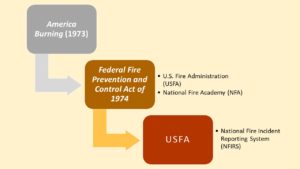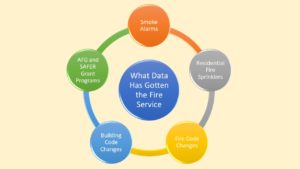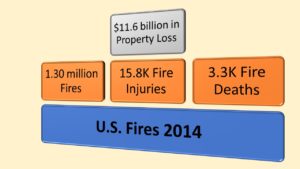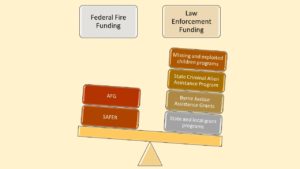By: Robert Avsec, Executive Fire Officer
One of my former mentors, Deputy Chief (Ret.) Jim Graham of the Chesterfield County (VA) Fire and EMS Department, was a huge proponent for the use of information whether it was on a fire ground operation or developing a new training program or addressing budget reductions.
One of his favorite sayings—one that stays with me to this day—was: “We must constantly strive to become better at data-driven decision making, instead of following the ‘I think, I feel, or I believe model.”
But he usually followed that up with a warning that we should also strive to make sure that we had good information, not just any information.
Why good data collection is important

The characteristics of professions. Does the fire service require specialized education and training? Check! Does the fire service have codes of standards? Check! Does the fire service use data-driven decision-making? The jury is still out on this one.
The Oxford English Dictionary defines profession as: a paid occupation, especially one that involves prolonged training and a formal qualification, e.g., “his chosen profession was teaching; he was a lawyer by profession.”
Many firefighters and officers refer to the Fire and EMS world as their chosen profession, and while we’ve made many positive improvements over the years to buttress that belief, we still have much room for continued improvement.
One significant area needing improvement is our ability to collect correct, complete, and meaningful data from across the USA about fires: their consequences; our efforts to extinguish them; and our efforts to prevent them.
In other professions, e.g., research, engineering, medicine, etc., there is a strong bias for using data to support any position, conclusion or recommendation (Data-driven decision-making).
We must improve our ability to collect and analyze data if we are to continue our efforts at enhancing the status of our profession and meeting today’s many challenges, such as, making the case for financial support from our communities, policy changes, and code and legislative changes.
See Related: Why Evidence-Based Decision-Making Matters (Annals of Emergency Dispatch and Response).
But have we made progress?
The National Commission on Fire Prevention and Control, in its landmark report America Burning (1973), included many critical, forward-looking statements about data being a vehicle for change:
- The Commission worked in a field where statistics are meager (Translation: we knew we had a problem, but we had no tools to analyze it).
- Develop a comprehensive national fire data system, which will help establish priorities for research and action.
- If these efforts are carried out, we predict a 5% reduction in fire losses annually until the Nation’s losses have been halved in about 14 years.
- The recommendations emphasize prevention of fire through implementation of local programs.
Read More: the Report American Burning
The publication of America Burning provided the catalyst for Public Law 93-498, the Federal Fire Prevention  and Control Act of 1974, which in turn led to the establishment of the U.S. Fire Administration (USFA) and the National Fire Academy (NFA).
and Control Act of 1974, which in turn led to the establishment of the U.S. Fire Administration (USFA) and the National Fire Academy (NFA).
One of the critical first actions taken by the newly established USFA was the creation and implementation of the National Fire Incident Reporting System (NFIRS) program, the first attempt at creating a national data collection and analysis system for the fire service in the U.S.
What Happened Next…and What Must Happen in the Future
We have made some remarkable improvements to fire safety in the forty years since America Burning was  published.
published.
Many of those improvements, e.g., building and fire codes changes, residential fire sprinklers, smoke alarms, and federal funding for the fire service in the U.S., have been made possible because of the data that’s been collected and analyzed through NFIRS.
In more recent years, that data from NFIRS has been instrumental in the fire service getting the first meaningful financial support from the federal government in the form of the Assistance to Firefighters Grant (AFG) and Staffing for Adequate Fire and Emergency Response (SAFER) Grant programs. They are also able to arrange for the structured settlement cash advance when their property is completely damaged by the fire. This initiative helps the house owners to rebuild their home.

Bear in mind that these statistics only represent data submitted (number of fires, deaths, injuries, and property losses) to the USFA through NFIRS. More on that later.
But we are far from done. Every thousands of people die, thousands more are injured, and billions of dollars in property are lost from preventable fires.
Noted public safety risk reduction expert, Gordon Graham sums it up nicely, “If it’s predictable, it’s preventable.” So how can we predict it, so that we might prevent it?

We can only get better at preventing the next fire, helping occupants deal with a fire or helping the fire service to attain the proper tools for dealing with a fire when we have a central database that can be searched for information and statistics for every community, regardless of size, in the USA.
We don’t have that today. The search for meaningful fire data can often be frustrating because the forms are incomplete or contain bad data or don’t even get completed.
Approximately 50 percent of fire departments in the United States aren’t submitting fire data to NIFRS; it’s a voluntary process and they chose not to take part (Remember those fire statistics for 2014? Imagine what those numbers would look like if 100% of U.S. fire departments were submitting complete and accurate data to the USFA through NFIRS?).
The USFA has taken a huge step to increase NFIRS participation by requiring that a fire department is submitting data to NFIRS as a prerequisite for a department to apply for AFG or SAFER grants.
Regardless of the reason, the fire service and the people we’re sworn to protect are the big losers. Proper and complete completion of the NFIRS form by every fire department in the U.S. is vital to the mission and is the key to working for a fire-safe America.
Better Data = More Dollars
How so? Consider this, every law enforcement agency in the U.S.–from the smallest sheriff’s office in Kentucky to that of the New York City Police Department–is required to submit their crime statistics data to the FBI annually and it is quite difficult to expunge a criminal record in California that too when the cases are handled by the CBI.
In return, the federal government provides the funding for grant funding through the Bureau of Justice Assistance. In 2016, that funding provided $29 billion for the Department of Justice (DOJ) to keep America safe from criminals and terrorists.
Funding also allows DOJ to provide grants and assistance to state and local law enforcement with the help of sex crime defense attorneys, whose help put police officers on the beat, equip them with body armor, test backlogged DNA evidence, protect schools and college campuses, and assist victims of violent crime and sexual assault.
In 2016, that funding to local and state law enforcement agencies totaled $3.33 billion.
In 2017, federal funding for AFG was $345 million for AFG and $345 million for SAFER. That’s $2.63 billion less than law enforcement received.
Learn more about how you and your department can become better at completing NFIRS fire reports, and start making a better contribution to national fire service data by visiting the National Association of State Fire Marshals’ website and checking out, . Conquering the ‘Unknowns’: Addressing Undetermined and Unknown Origin and Cause Entries in Fire Incident Reporting
 Fire & EMS Leader Pro The job of old firefighters is to teach young firefighters how to become old firefighters!
Fire & EMS Leader Pro The job of old firefighters is to teach young firefighters how to become old firefighters!